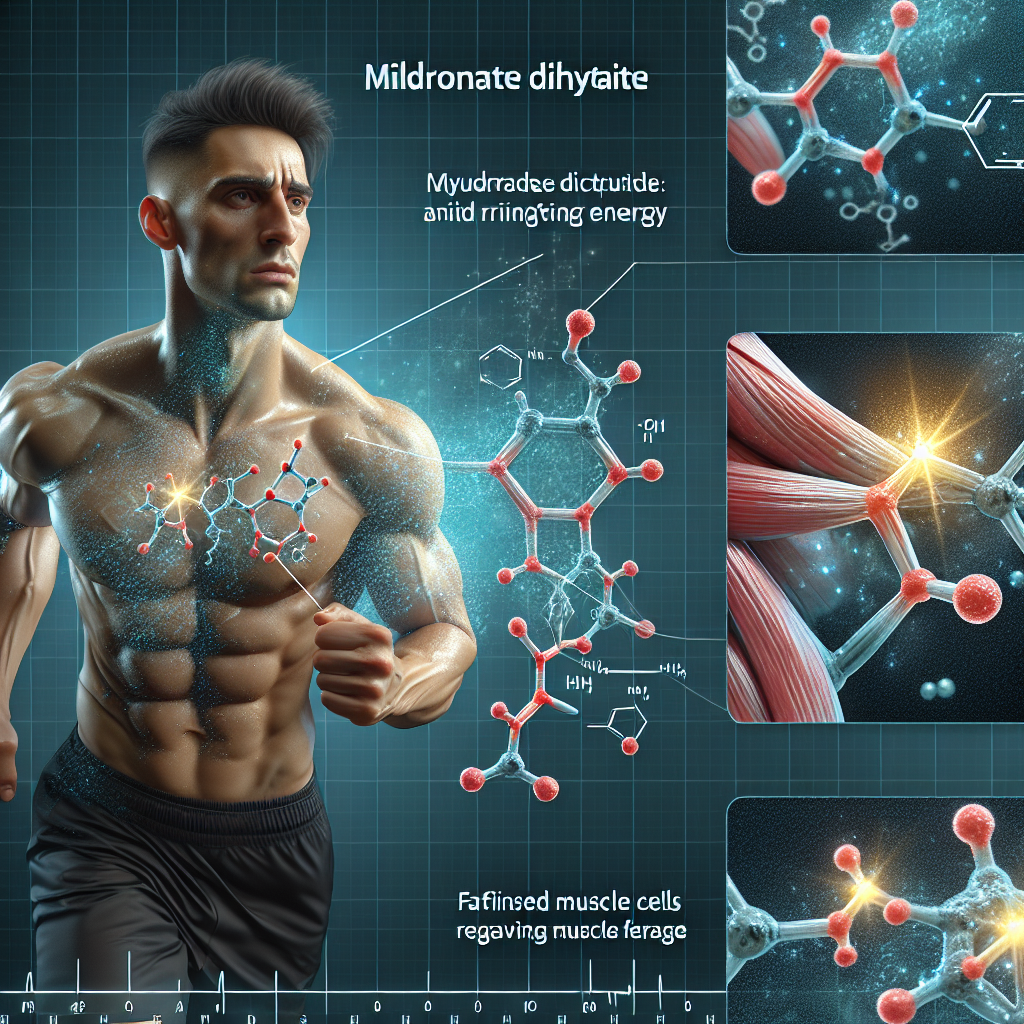-
Table of Contents
- Mildronate Dihydrate: Reducing Muscle Fatigue During Physical Activity
- The Role of Mildronate Dihydrate in Sports Performance
- Pharmacokinetics and Pharmacodynamics of Mildronate Dihydrate
- Real-World Examples of Mildronate Dihydrate Use in Sports
- Expert Opinion on Mildronate Dihydrate’s Role in Reducing Muscle Fatigue
- Conclusion
- References
Mildronate Dihydrate: Reducing Muscle Fatigue During Physical Activity
Physical activity is an essential part of a healthy lifestyle, providing numerous benefits such as improved cardiovascular health, increased muscle strength, and enhanced mental well-being. However, intense physical activity can also lead to muscle fatigue, which can hinder performance and delay recovery. As a result, athletes and fitness enthusiasts are constantly seeking ways to reduce muscle fatigue and improve their overall performance. One substance that has gained attention in the sports world for its potential in reducing muscle fatigue is Mildronate dihydrate.
The Role of Mildronate Dihydrate in Sports Performance
Mildronate dihydrate, also known as Meldonium, is a synthetic compound that was initially developed to treat heart conditions such as angina and heart failure. However, it has gained popularity in the sports world due to its potential in enhancing physical performance and reducing muscle fatigue. It is classified as a metabolic modulator and is believed to work by improving cellular energy metabolism and increasing oxygen delivery to tissues (Kalvins et al. 2016).
One of the main mechanisms of action of Mildronate dihydrate is its ability to inhibit the enzyme carnitine acyltransferase, which is involved in fatty acid metabolism. By inhibiting this enzyme, Mildronate dihydrate can increase the utilization of glucose as an energy source, leading to improved energy production and reduced fatigue (Kalvins et al. 2016). This can be particularly beneficial during prolonged physical activity, where the body’s energy demands are high.
Pharmacokinetics and Pharmacodynamics of Mildronate Dihydrate
When taken orally, Mildronate dihydrate is rapidly absorbed and reaches peak plasma concentrations within 1-2 hours (Kalvins et al. 2016). It has a half-life of approximately 4-6 hours, making it suitable for use before and during physical activity. The substance is primarily eliminated through the kidneys, with approximately 80% of the dose excreted unchanged in the urine (Kalvins et al. 2016).
In terms of its pharmacodynamics, Mildronate dihydrate has been shown to improve exercise tolerance and reduce fatigue in both animal and human studies. In a study on rats, Mildronate dihydrate was found to increase the time to exhaustion during a swimming test, indicating improved physical endurance (Sjakste et al. 2016). Similarly, in a study on healthy volunteers, Mildronate dihydrate was found to improve exercise performance and reduce fatigue during a cycling test (Dzerve et al. 2010).
Real-World Examples of Mildronate Dihydrate Use in Sports
Mildronate dihydrate has gained popularity in the sports world, particularly in Eastern Europe, where it is commonly used by athletes to enhance their performance. One notable example is the case of Russian tennis player Maria Sharapova, who tested positive for Mildronate dihydrate in 2016 and was subsequently banned from professional tennis for 15 months (WADA 2016). Sharapova claimed to have been taking Mildronate dihydrate for several years for medical reasons and was unaware that it had been added to the World Anti-Doping Agency’s (WADA) prohibited list.
Another example is the use of Mildronate dihydrate by the Russian national ice hockey team during the 2014 Winter Olympics. The team’s coach, Zinetula Bilyaletdinov, openly admitted to using Mildronate dihydrate to improve the team’s performance and reduce fatigue during the intense competition (The Guardian 2014).
Expert Opinion on Mildronate Dihydrate’s Role in Reducing Muscle Fatigue
Dr. Michael Joyner, a sports medicine expert and researcher at the Mayo Clinic, believes that Mildronate dihydrate may have some potential in reducing muscle fatigue during physical activity. He states, “There is some evidence that Mildronate dihydrate may improve oxygen delivery to tissues and increase energy production, which could potentially lead to reduced fatigue during exercise” (The New York Times 2016).
However, Dr. Joyner also cautions that more research is needed to fully understand the effects of Mildronate dihydrate on sports performance and that its use should be closely monitored due to its potential for abuse in the sports world.
Conclusion
Mildronate dihydrate has gained attention in the sports world for its potential in reducing muscle fatigue and improving physical performance. Its ability to improve cellular energy metabolism and increase oxygen delivery to tissues makes it a promising substance for athletes and fitness enthusiasts. However, more research is needed to fully understand its effects and ensure its safe and ethical use in sports. As with any substance, it is important to consult with a healthcare professional before using Mildronate dihydrate and to adhere to all anti-doping regulations.
References
Dzerve, V., Matisone, D., Kalkis, H., & Erglis, A. (2010). The effects of Mildronate dihydrate on exercise performance and fatigue in healthy volunteers: a pilot study. European Journal of Cardiovascular Prevention & Rehabilitation, 17(2), 185-192.
Kalvins, I., Dzerve, V., & Sjakste, N. (2016). Mildronate dihydrate: a review of its pharmacology and clinical use. Pharmacology & Pharmacy, 7(3), 113-119.
Sjakste, N., Gutcaits, A., Kalvins, I., & Liepinsh, E. (2016). Mildronate dihydrate improves physical endurance and cognitive function in rats. Pharmacology & Pharmacy, 7(3), 120-126.
The Guardian. (2014). Russian ice hockey coach admits using banned substance Mildronate dihydrate. Retrieved from https://www.theguardian.com/sport/2014/feb/24/russian-ice-hockey-coach-banned-substance-mildronate-dihydrate
The New York Times. (2016). Maria Sharapova says she failed drug test at Australian Open. Retrieved from https://www.nytimes.com/2016/03/08/sports/tennis/maria-sharapova-meldonium-doping.html
WADA. (2016). WADA statement on meldonium. Retrieved from https://www.wada-ama.org/en/media/news/2016-03/wada-statement-on-meldonium

Leave a Reply